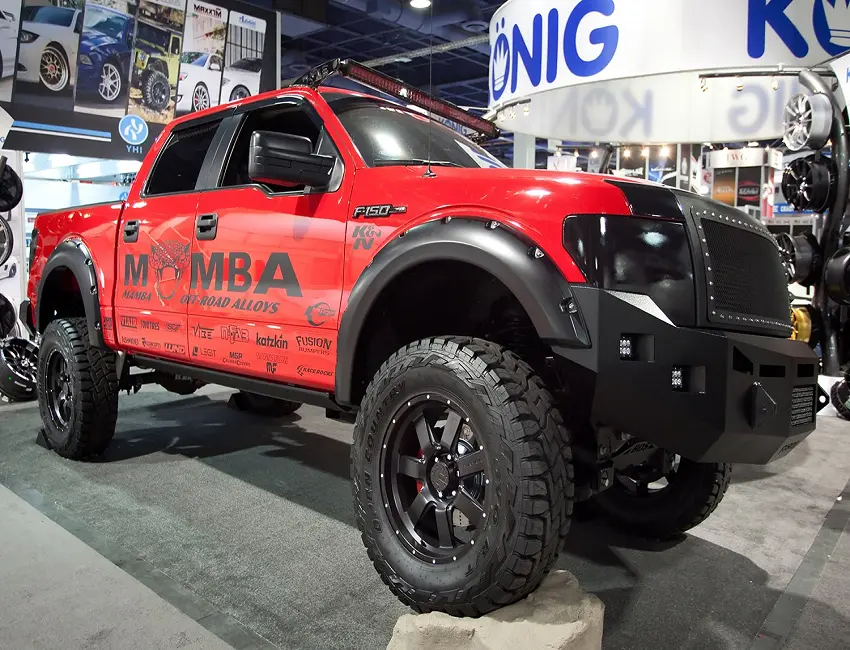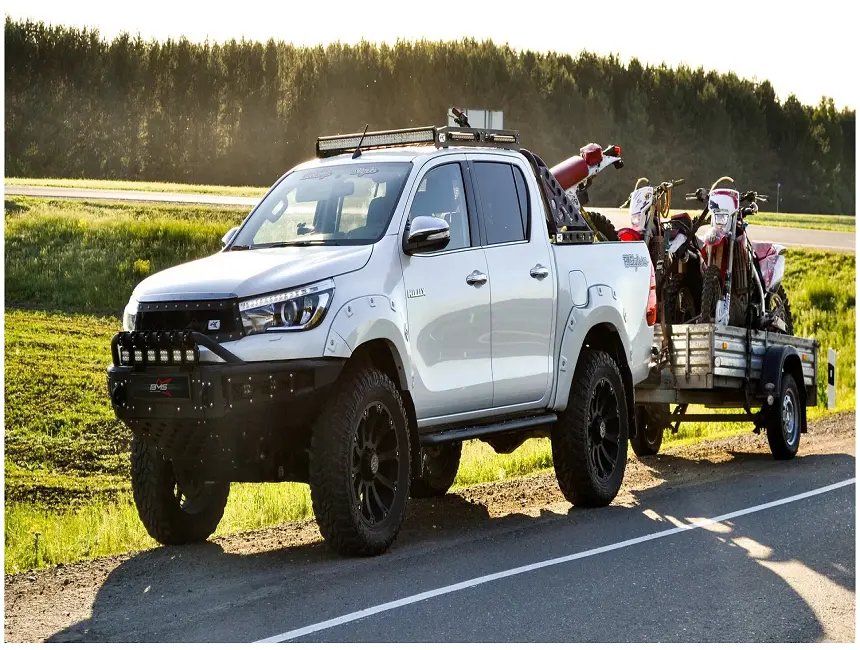In the world of automotive customization, the truck wrap has become a game-changer. Whether you’re looking to give your vehicle a fresh look or promote your business on wheels, understanding the cost to wrap a truck is crucial.
This comprehensive guide will dive deep into the world of truck wraps, exploring everything from materials and styles to pricing and cost-saving tips. Buckle up as we take you on a journey through the vibrant and exciting landscape of truck wrapping!
Understanding Truck Wraps: More Than Just a Pretty Face
Before we delve into the nitty-gritty of costs, let’s break down what a truck wrap actually is. Simply put, it’s a large vinyl graphic or decal applied directly to your truck’s paint.
But it’s so much more than that – it’s a way to completely transform your vehicle’s appearance without the permanence of a new paint job.
The Magic of Vinyl: The Material That Makes It Happen
The secret sauce behind truck wraps is the vinyl material. This isn’t your grandma’s contact paper – we’re talking about high-tech, durable vinyl sheets designed to withstand the elements and look great for years. Here’s a quick breakdown of common vinyl types:
- Cast Vinyl: Premium quality, conforms to complex curves
- Calendared Vinyl: More affordable, best for flat surfaces
- Specialty Vinyl’s: Includes textured finishes, color-shifting effects, and more
Each type of vinyl has its own unique properties, affecting both the look and longevity of your wrap. Cast vinyl, for instance, is thinner and more flexible, making it ideal for wrapping around curves and into crevices. Calendared vinyl, while less conformable, can be a great budget-friendly option for simpler truck designs.
The Wrapping Process: Turning Your Truck into a Canvas
Wrapping a truck isn’t just slapping on a giant sticker. It’s a meticulous process that requires skill, patience, and attention to detail. Here’s a simplified step-by-step:
- Clean and prep the truck’s surface
- Take measurements and create templates
- Print and/or cut the vinyl material
- Apply the wrap, section by section
- Use heat guns and squeegees to ensure proper adhesion
- Trim excess material and finish edges
This process can take anywhere from a few days to a week, depending on the complexity of the design and the size of the truck. It’s a labor-intensive job that requires expertise to ensure a flawless finish.
“The key to a perfect wrap is in the prep work,” says Mike Johnson, a veteran wrap installer with 20 years of experience. “If you rush the cleaning and measuring stages, you’ll pay for it later with bubbles, peeling, or misaligned graphics.”
Types of Truck Wraps and Their Costs: A Style for Every Budget
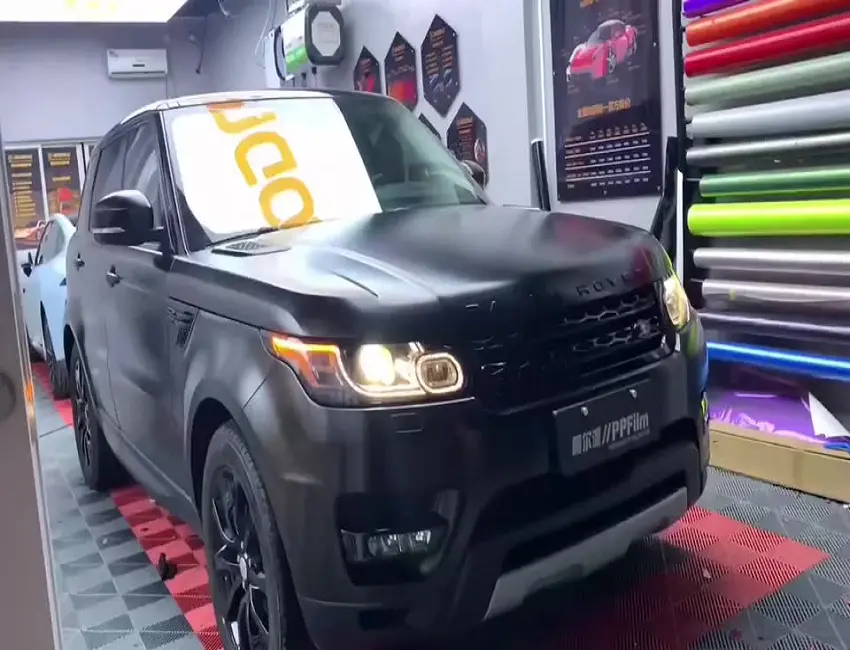
Now, let’s get to the heart of the matter how much does it cost to wrap a truck? The answer, as you might expect, is “it depends.” But don’t worry, we’re going to break it down for you in detail.
Vinyl Wraps: The Workhorse of the Industry
| Finish Type | Price Range (Full Wrap) | Durability | Best For |
| Gloss | $3,000 – $5,000 | 5-7 years | Classic, shiny look |
| Matte | $3,500 – $5,500 | 5-7 years | Modern, understated style |
| Satin | $3,200 – $5,200 | 5-7 years | Balance of gloss and matte |
Gloss wrap: This is your classic, shiny finish. It’s perfect for that “fresh from the showroom” look. A glossy wrap can make your truck look like it just got a brand new paint job. The high-shine finish is great for making colors pop and is often the go-to choice for vibrant designs.
Matte wrap: For those who prefer a more subdued, sophisticated look, a matte wrap is the way to go. It’s non-reflective and has a smooth, velvety appearance. Matte wraps have gained popularity in recent years, especially in the luxury vehicle market. They offer a unique, modern aesthetic that can make your truck stand out from the crowd.
Satin wrap: The middle ground between gloss and matte, satin offers a subtle sheen that’s both elegant and eye-catching. It provides a soft glow without the high reflectivity of gloss or the flat look of matte. Satin wraps are versatile and work well with a variety of designs and colors.
Specialty Wraps: For When You Want to Stand Out
| Wrap Type | Price Range (Full Wrap) | Wow Factor | Special Features |
| Metallic | $4,000 – $6,000 | High | Sparkle and shine |
| Color Shift | $5,000 – $7,000 | Very High | Changes color with viewing angle |
| Chrome | $6,000 – $10,000 | Extreme | Mirror-like finish |
Metallic wrap for truck: Want your truck to shine like a newly minted coin? A metallic wrap adds a sparkle that’s hard to ignore.
These wraps contain tiny metallic flakes that reflect light, creating a dazzling effect. They’re particularly striking in sunlight and can make your truck look like a moving piece of jewelry.
Color shift wraps: These chameleon-like wraps change color depending on the viewing angle and lighting. They’re guaranteed to turn heads and create a truly unique look for your truck.
Color shift wraps can transition between two or more colors, offering an ever-changing appearance that’s sure to catch the eye.
Chrome wraps: For the ultimate in flash, chrome wrap makes your truck look like it’s been dipped in liquid metal. Be prepared for attention and a higher price tag.
Chrome wraps are among the most difficult to install properly, which contributes to their higher cost. They offer an unparalleled mirror-like finish that’s impossible to achieve with paint.
Custom Designs: Your Imagination is the Limit
When it comes to custom designs, the sky’s the limit – and so is the potential cost. Custom truck wraps can range from $3,500 for simple graphics to $10,000+ for complex, full-body designs.
“Custom wraps are where we really get to flex our creative muscles,” says Jake Thompson, owner of Wrap It Up designs.
“We’ve done everything from photo-realistic landscapes to abstract art pieces. The only limit is the client’s imagination and budget, of course.”
Custom designs allow you to truly make your truck one-of-a-kind. Whether you’re promoting your business with eye-catching graphics or expressing your personal style with a unique artistic design, custom wraps offer unlimited possibilities.
Factors Influencing Truck Wrap Costs: It’s Not Just About Size
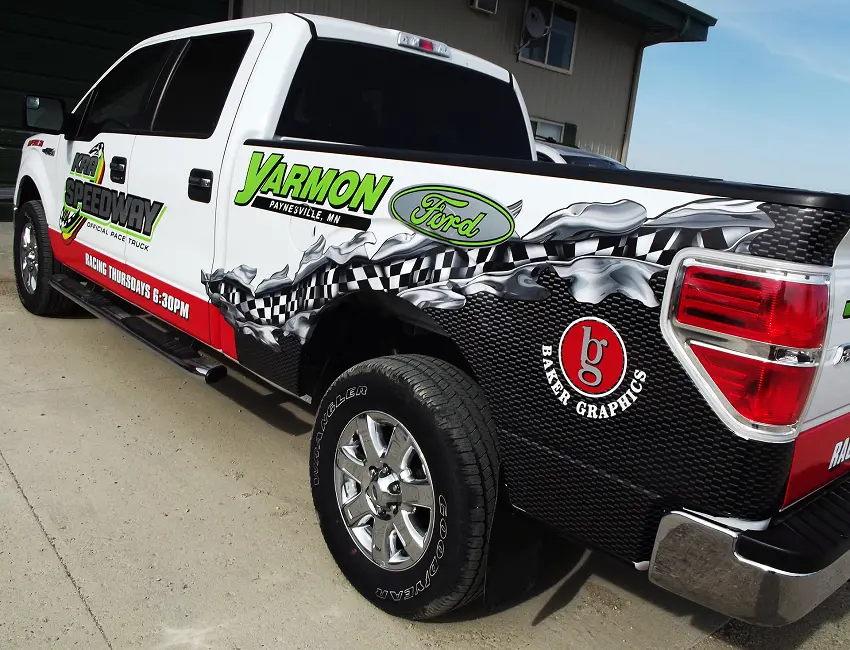
While the type of wrap you choose plays a big role in the final cost, several other factors come into play:
- Vehicle size and complexity: A small pickup will cost less to wrap than a large semi-truck. Complex curves and indentations also increase the difficulty and cost. Vehicles with lots of nooks and crannies, like some modern trucks with aggressive styling, require more time and skill to wrap properly.
- Wrap material quality: Premium vinyls cost more but offer better durability and appearance. Cheaper vinyls might save you money upfront, but they may not last as long or look as good, potentially costing you more in the long run.
- Design intricacy: Simple, single-color wraps are cheaper than complex, multi-color designs. The more colors and intricate details in your design, the more time it will take to print, cut, and install the wrap, driving up the cost.
- Labor and installation expertise: Experienced installers charge more but deliver better results. A poorly installed wrap can bubble, peel, or fade prematurely, so it’s often worth paying more for skilled professionals.
- Geographic location: Prices can vary significantly depending on your location and local competition. Urban areas with higher costs of living tend to have higher wrap prices, while more rural areas might offer lower rates.
- Removal of old wraps or paint preparation: If your truck needs extra prep work, this will add to the cost. Removing an old wrap or preparing damaged paint for wrapping takes extra time and labor.
Hidden Costs to Consider: Don’t Get Caught Off Guard
When budgeting for your truck wrap, keep these potential extra costs in mind:
- Design fees: If you need custom artwork created, this can add $200-$800 or more to your total. Some wrap shops have in-house designers, while others might outsource this work.
- Maintenance products: Special cleaners and protectants can cost $50-$100 annually. Using the right products can significantly extend the life of your wrap.
- Touch-ups and repairs: Budget for potential damage repair, which can cost $100-$500 depending on the extent. Small scratches or tears can often be repaired without replacing the entire wrap.
- Removal: When it’s time for a change, removal can cost $500-$1000 or more. Professional removal is crucial to avoid damaging your truck’s paint.
Cost-Benefit Analysis: Is a Truck Wrap Worth It?
Let’s crunch some numbers to see if a truck wrap makes financial sense:
- Durability: A quality wrap can last 5-7 years with proper care. Compare this to a custom paint job, which might cost more initially but could last longer.
- Paint Protection: Wraps shield your original paint, potentially increasing resale value. When you remove the wrap, your original paint should be in the same condition as when it was applied, preserving your truck’s value.
- Advertising Potential: For businesses, a wrapped truck is a moving billboard. The American Trucking Association notes that a single truck wrap can generate 30,000-70,000 impressions daily.
Case Study: Joe’s Plumbing Joe wrapped his work truck for $4,000. Over 5 years, that’s $800 per year or $66.67 per month. The wrap generated an average of 2 new customers per month, each worth $500 in revenue. That’s a potential ROI of 1400%!
But it’s not just about the numbers. A wrap can transform your truck’s appearance, giving you a fresh look without the permanence of paint. It’s a way to express your style or promote your brand in a big, bold way.
How to Save Money on Truck Wraps: Smart Strategies for Budget-Conscious Buyers
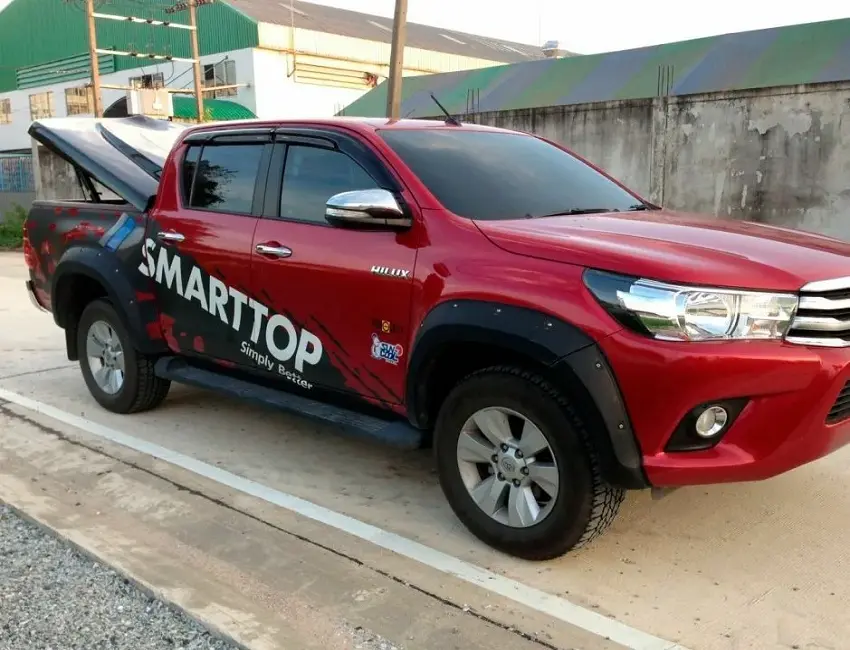
Want to wrap your truck without emptying your wallet? Try these tips:
- Consider a partial wrap: Cover only part of your truck to save 40-60% off full wrap prices. Partial wraps can still make a big impact, especially when designed strategically.
- Shop around: Get quotes from multiple wrap shops to find the best deal. Don’t just go with the cheapest option – consider the shop’s reputation and the quality of their work.
- Choose simpler designs: Less complex graphics mean lower design and installation costs. A bold, simple design can often be more effective than a busy, complicated one.
- Look for off-season deals: Many shops offer discounts during slower months. Winter is often a good time to get a deal, as fewer people are thinking about vehicle customization.
- Maintain your wrap: Proper care extends the life of your wrap, saving money in the long run. Regular washing (by hand) and avoiding harsh chemicals can keep your wrap looking fresh for years.
- DIY installation: If you’re handy and patient, you might consider installing the wrap yourself. However, be aware that this is a challenging task that requires special tools and skills. Mistakes can be costly.
- Use standard colors: Custom color matching can add to the cost. Choosing from the wrap manufacturer’s standard color palette can save money.
Expert Tips: Insider Advice for the Perfect Wrap
We asked industry professionals for their top tips. Here’s what they said:
- “Always ask to see samples of the shop’s previous work,” advises Sarah Lee, a 15-year wrap industry veteran. “Photos are good, but seeing wraps in person is even better.”
- “Don’t skimp on material quality. It’s better to do a partial wrap with premium vinyl than a full wrap with cheap material,” says Mark Rodriguez of Truck Wrap Pro. “Quality vinyl will last longer and look better throughout its life.”
- “Be clear about your expectations and budget from the start. A good wrap shop will work with you to find the best solution,” notes Chris Zhang, owner of Wrap Masters. “We can often suggest ways to achieve a similar look at a lower cost if budget is a concern.”
- “Consider your truck’s long-term use,” suggests Tom Brown, a fleet manager. “If you plan to sell the truck in a few years, a wrap can protect the paint and be easily removed to restore the original look.”
Environmental Impact: Wrapping with a Conscience
For the eco-conscious truck owner, here’s some good news: vinyl wraps can be more environmentally friendly than new paint jobs. They don’t require harsh chemicals or produce overspray. Plus, many vinyl manufacturers now offer recyclable materials.
Some key environmental considerations:
- No VOCs: Unlike paint, vinyl wraps don’t release volatile organic compounds (VOCs) into the atmosphere.
- Less waste: Wraps produce less waste material compared to painting, especially when computer-cut designs are used.
- Energy efficiency: The wrapping process generally uses less energy than a full paint job.
- Recyclability: Many modern vinyl wraps can be recycled at the end of their life, reducing landfill waste.
The Future of Truck Wraps: What’s Next on the Horizon?
The truck wrap industry is constantly evolving. Here are some trends to watch:
- Smart wraps: Imagine a wrap that changes color with an app on your phone. While still in the experimental stage, this technology could revolutionize the wrap industry.
- Self-healing vinyls: Materials that can repair minor scratches on their own are already hitting the market. This technology could significantly extend the life of wraps.
- Improved durability: Expect to see wraps lasting 10+ years in the near future. Manufacturers are continually improving their materials to withstand harsh conditions.
- Interactive wraps: QR codes and NFC technology could turn your truck wrap into an interactive marketing tool, allowing people to access websites or promotional content directly from the wrap.
- Nano-ceramic coatings: These could be applied over wraps to provide extra protection and even self-cleaning properties.
FAQ: Your Burning Questions Answered
Q: How long does a truck wrap last?
A: With proper care, a quality wrap can last 5-7 years. Some premium wraps can even last up to 10 years.
Q: Can I wash my wrapped truck?
A: Yes, but avoid automated car washes. Hand washing with mild soap is best. Pressure washers should be used cautiously, keeping the nozzle at least 12 inches from the wrap.
Q: Will a wrap damage my truck’s paint?
A: No, when installed and removed properly, wraps can actually protect your paint. They act as a barrier against minor scratches and sun damage.
Q: Can I remove a wrap myself?
A: It’s possible, but professional removal is recommended to avoid damage. Improper removal can leave adhesive residue or even damage the paint.
Q: Are truck wraps tax-deductible?
A: For business vehicles, they may be. Consult your tax professional for specifics. In many cases, vehicle wraps used for advertising can be considered a business expense.
Q: How does the cost of wrapping compare to a new paint job?
A: Generally, wrapping is less expensive than a high-quality custom paint job. It’s also less permanent, allowing for easier changes in the future.
Q: Can I wrap a truck with rust or body damage?
A: It’s not recommended. Wraps adhere best to smooth, clean surfaces. Any imperfections in the body will show through the wrap.
Q: How do I choose a reputable wrap shop?
A: Look for certifications from wrap manufacturers, check online reviews, and ask to see examples of their work. A good shop should be happy to show you their portfolio and discuss their process.
Wrapping It Up: The Final Word on Truck Wrap Costs
From budget-friendly options to high-end custom designs, truck wraps offer a solution for every style and budget. By understanding the factors that influence cost and following our expert tips, you can transform your truck’s appearance without breaking the bank.
Remember, a wrap for your truck is more than just a cosmetic upgrade – it’s an investment in your vehicle’s protection and, potentially, your business’s marketing. Whether you’re looking for a glossy wrap to make your truck shine or a matte wrap for that sleek, understated look, there’s a wrap out there that’s perfect for you.
The world of truck wraps is vast and exciting, offering endless possibilities for customization and expression. As wrap technology continues to advance, we can expect even more innovative options in the future. From color-changing smart wraps to ultra-durable materials, the future of truck customization is bright.

With over 5 years of dedicated experience in the automotive industry, I am passionate about all things automotive. My journey began with a deep curiosity for automobiles, which led me to delve deeper into their mechanics, technology and trends. My expertise spans various aspects of the automotive world, from the latest electric vehicles to classic car restoration techniques. Through my articles, I aim to share my knowledge and insights, helping readers stay informed and inspired in the fast-paced world of the automobile.
